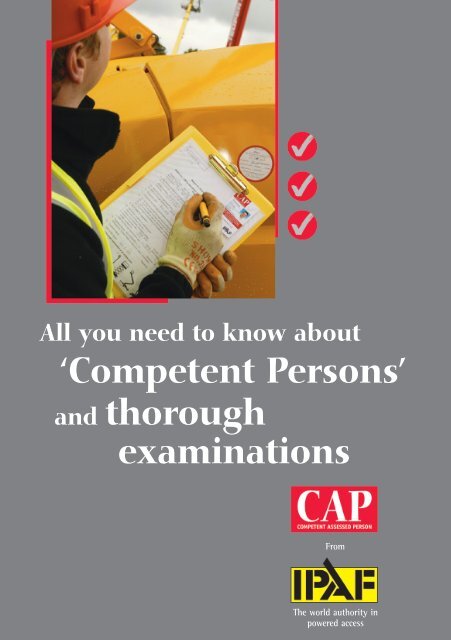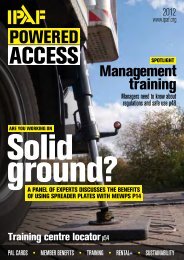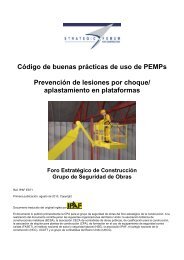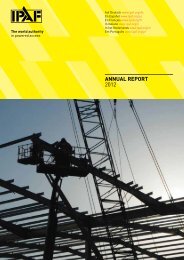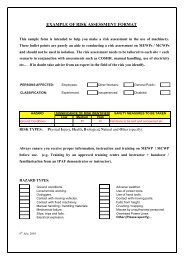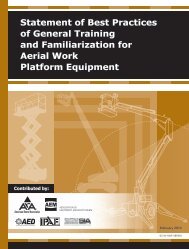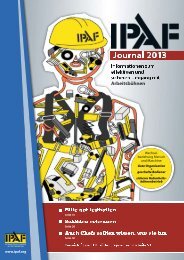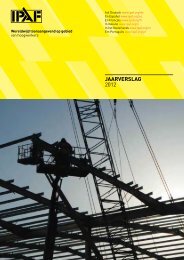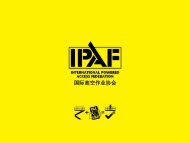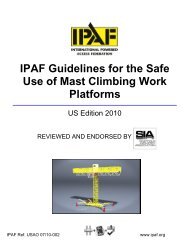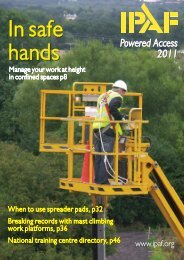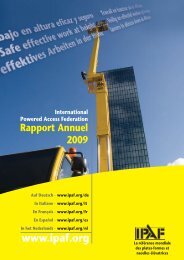'Competent Persons' and thorough examinations - IPAF
'Competent Persons' and thorough examinations - IPAF
'Competent Persons' and thorough examinations - IPAF
You also want an ePaper? Increase the reach of your titles
YUMPU automatically turns print PDFs into web optimized ePapers that Google loves.
All you need to know about<br />
‘Competent Persons’<br />
<strong>and</strong> <strong>thorough</strong><br />
<strong>examinations</strong><br />
From<br />
The world authority in<br />
powered access
3<br />
4<br />
4<br />
5<br />
6<br />
6<br />
7<br />
8<br />
CONTENTS<br />
Foreword by Tim Whiteman<br />
The legislation<br />
Help with compliance<br />
Who is responsible?<br />
Who is competent?<br />
Interpretative guidance<br />
Competence culture<br />
What is a <strong>thorough</strong> examination?<br />
FOREWORD<br />
Everyone who owns or operates any form of powered access equipment –<br />
mobile elevating work platforms (MEWPs) or mast climbing work platforms<br />
(MCWPs) – needs to underst<strong>and</strong> fully the concepts <strong>and</strong> implications of<br />
competent persons required to plan, manage <strong>and</strong> carry out <strong>thorough</strong><br />
<strong>examinations</strong> in the context of LOLER.<br />
The introduction of the Work at Height Regulations changes nothing. The<br />
same requirements are included through specific reference to LOLER.<br />
Those who fail to observe this duty, will find themselves in conflict with, <strong>and</strong><br />
open to prosecution by, the Health <strong>and</strong> Safety Executive. They lay themselves<br />
open to successful civil actions <strong>and</strong> serious criminal charges. In addition to<br />
putting lives at risk, they also jeopardise their own business through the<br />
potentially serious financial consequences of accidents <strong>and</strong> machine failures.<br />
It makes sense to incorporate the statutory requirements for inspection <strong>and</strong><br />
examination into maintenance schedules in the interest of reliability as well as<br />
safety. This feeds through directly to reduced downtime <strong>and</strong> increased<br />
profitability for all concerned.<br />
8<br />
Planning for <strong>thorough</strong> <strong>examinations</strong><br />
9<br />
9<br />
Intervals between <strong>thorough</strong> <strong>examinations</strong><br />
Preparation of an examination scheme<br />
Tim Whiteman<br />
Managing Director<br />
<strong>IPAF</strong><br />
11<br />
Elements of a recommended safety assurance package<br />
11<br />
Conclusion<br />
3
THE LEGISLATION<br />
LOLER, introduced with PUWER 98 at the end of 1998, first made regular <strong>thorough</strong><br />
<strong>examinations</strong> of all lifting equipment a legal requirement. The legislation required that<br />
this, previously advisory, duty must be carried out by a competent person.<br />
The Work at Height Regulations retain the same duty with specific reference to<br />
LOLER. They also extend the general requirement of inspection by a competent person<br />
to all equipment used for work at height.<br />
It is against the law to use, or allow to be used, powered access equipment<br />
that does not have documented evidence of a <strong>thorough</strong> examination by a<br />
competent person.<br />
HELP WITH COMPLIANCE<br />
<strong>IPAF</strong> has worked closely with the Health <strong>and</strong> Safety Executive (HSE) for many years<br />
to improve the safety of those who work at height. It was the HSE that first suggested it<br />
establish training courses for access platform operators. This training now includes<br />
demonstrators <strong>and</strong> instructors on MEWPs (mobile elevating work platforms) <strong>and</strong><br />
installers, demonstrators <strong>and</strong> instructors on MCWPs (mast climbing work platforms)<br />
<strong>and</strong> extends to courses covering safety harness use <strong>and</strong> inspection.<br />
The <strong>IPAF</strong> Competent Assessed Persons (CAP) Scheme focuses on another crucial<br />
aspect of safety – that of the machine itself. It is intended to provide guidance for<br />
platform engineers on compliance with regulatory requirements <strong>and</strong> to offer<br />
documented evidence that individuals can be regarded as competent persons to plan,<br />
manage or carry out <strong>thorough</strong> <strong>examinations</strong> of powered access equipment within the<br />
context of current legislation.<br />
The CAP Scheme complements <strong>IPAF</strong>’s operator training courses by extending the<br />
promotion of a ‘safety culture’ to machine maintenance as well as operation. It uses<br />
experienced engineers to provide the orientation <strong>and</strong> guidance sessions as well as to<br />
carry out the assessment that forms a key element of the CAP Scheme.<br />
These experts have spent most of their working lives in design <strong>and</strong> technical<br />
production within the mechanical h<strong>and</strong>ling <strong>and</strong> lifting industries. They are uniquely<br />
familiar with all aspects of equipment design <strong>and</strong> manufacturing technology, its<br />
examination, relevant legislative requirements <strong>and</strong> their interpretation.<br />
The information outlined here is derived from the practical guidance on the<br />
responsibilities <strong>and</strong> duties of competent persons that is provided to c<strong>and</strong>idates at CAP<br />
Orientation <strong>and</strong> Guidance sessions that precede the assessments.<br />
WHO IS RESPONSIBLE?<br />
Everyone involved, directly or indirectly, in the use of a platform, either a MEWP or an<br />
MCWP, carries a responsibility for ensuring that <strong>examinations</strong> have been carried out.<br />
This will include the owner or supplier, which may be hire company A; the cross-hirer,<br />
which may be hire company B; the user, who may be a contractor on a site <strong>and</strong> the site<br />
owner, operator or controller. All platforms must carry proof of examination. This may<br />
be a sticker identifying the date of the previous examination, when the next one is due<br />
<strong>and</strong> a report reference, or a copy of the Inspection Certificate.<br />
If platforms are used without such confirmatory evidence of examination then<br />
everyone involved is liable to prosecution.<br />
There is still a degree of concern over “How competent is ‘competent’?” <strong>and</strong> “How<br />
<strong>thorough</strong> is ‘<strong>thorough</strong>’?”<br />
Certificate No. CAP/30000 Expiry Date: 31/01/13<br />
Signed for <strong>and</strong> on behalf of <strong>IPAF</strong>:<br />
Competent Assessed Person<br />
Certificate<br />
I certify that<br />
A C Person<br />
has satisfied <strong>IPAF</strong> Limited on<br />
15/01/08<br />
that they were fit to act as a “competent person” in the examination of the<br />
following types of mobile elevating work platforms<br />
1a, 1b, 3a, 3b, Planning & Management<br />
CAP Certificate <strong>and</strong><br />
Competent Assessed<br />
Person Card<br />
4<br />
5
WHO IS COMPETENT?<br />
Extensive prior case law provides general guidance on who will be seen as a competent<br />
person. Publications such as Redgrave, Fife <strong>and</strong> Machin, provide the definitive<br />
references to such legal precedents.<br />
Considerable clarification of the spirit <strong>and</strong> intentions of the legislation can be found in<br />
HSE publications such as ‘Safe use of lifting equipment’ (L113) – the Approved code of<br />
Practice <strong>and</strong> Guidance on LOLER <strong>and</strong> ‘Safe use of work equipment’ the Approved code<br />
of Practice <strong>and</strong> Guidance on PUWER 98 (L22).<br />
Direct contact with the HSE will provide invaluable general, practical guidance but<br />
cannot be expected to provide specific advice on exactly who is or is not 'competent'.<br />
Interpretive guidance<br />
A Competent Person must:<br />
• Have appropriate practical <strong>and</strong> theoretical knowledge <strong>and</strong> experience of the lifting<br />
equipment to be <strong>thorough</strong>ly examined.<br />
• Be sufficiently independent <strong>and</strong> impartial to allow objective decisions to be made,<br />
although this does not mean that they should be from an independent organisation.<br />
Examinations carried out by in-house staff are perfectly acceptable within the<br />
legislation.<br />
• Be able to carry out <strong>thorough</strong> <strong>examinations</strong> <strong>and</strong> interim inspections.<br />
• Decide on the need for inspections between <strong>thorough</strong> <strong>examinations</strong>.<br />
• Carry out an ongoing review of the periods between <strong>thorough</strong> <strong>examinations</strong>.<br />
• Following a <strong>thorough</strong> examination, notify the employer forthwith of any defect in<br />
the lifting equipment, which in his opinion is or could become a danger to persons.<br />
• As soon as is practicable after a <strong>thorough</strong> examination (normally within 28 days)<br />
make an authenticated report in writing.<br />
In addition they may be:<br />
•<br />
Required to draw up <strong>and</strong> authenticate an examination scheme <strong>and</strong> subsequently<br />
modify it in the light of changes.<br />
Competence culture <strong>and</strong> continual responsibility<br />
Whilst we need to refer to the letter of the law, it is <strong>IPAF</strong>’s opinion that a competent<br />
person needs to demonstrate more than this. Our approach is to encourage <strong>and</strong> foster a<br />
‘competence culture’ that seeks also to take on the spirit of the law <strong>and</strong> develop a<br />
methodology that addresses the prime responsibility of a competent person.<br />
In short, the competent person needs to become the guardian of the platform,<br />
continually responsible for its safety <strong>and</strong> able to recognise what influences its state of<br />
health through intimate knowledge of its history <strong>and</strong> day-to-day life.<br />
It is their responsibility to be able to confirm that the equipment subject to<br />
their examination <strong>and</strong> report is (or is not) now safe to operate.<br />
Those maintenance engineers, for example, who really underst<strong>and</strong> the platforms they<br />
work on, know their patterns of use <strong>and</strong> always look more carefully for a possible<br />
problem, certainly practise it. To them, a tight pin or shaft suggests the possibility of<br />
torsional fatigue rather than just wear. Tell-tale rust spots or stains on<br />
an apparently sound weld warn of possible internal corrosion.<br />
Local accident damage is not just repaired but its effect on<br />
other components is carefully considered.<br />
It is not necessary for a competent person to know all<br />
the answers, but it is vital that they have a ‘what if?’<br />
mentality <strong>and</strong> are prepared to seek further advice from<br />
manufacturers or experts whenever they are in doubt.<br />
Date of examination by competent person<br />
Examined by<br />
CAP Certificate No<br />
Report reference<br />
Test Centre<br />
(Block Capitals)<br />
www.ipaf.org<br />
Date of next <strong>thorough</strong> examination<br />
Machine inspection sticker<br />
6 7
WHAT IS A THOROUGH EXAMINATION?<br />
The purpose of <strong>thorough</strong> <strong>examinations</strong> <strong>and</strong>, if appropriate, inspections at suitable<br />
intervals between is ‘to ensure that health <strong>and</strong> safety conditions are maintained <strong>and</strong> that<br />
any deterioration can be detected <strong>and</strong> remedied in good time’.<br />
The 'competence culture' approach also goes a long way towards answering the<br />
examination <strong>thorough</strong>ness question. It goes further than examining a fixed list of items<br />
on a specific platform. As the legislation recognises, this changes with circumstances<br />
such as incidents, accidents <strong>and</strong> usage. It must also be influenced by what is discovered<br />
during the inspection. An apparently simple defect may suggest in depth examination of<br />
components that would otherwise not have needed such <strong>thorough</strong> investigation.<br />
They involve detailed examination of components <strong>and</strong> systems, carried out by visual<br />
inspection <strong>and</strong> testing <strong>and</strong>, where necessary, dismantling, stripping of paint,<br />
measurement <strong>and</strong> non-destructive testing.<br />
Many parts <strong>and</strong> systems of a platform will require examination at every <strong>thorough</strong><br />
examination. However, there may be parts <strong>and</strong> systems which, in addition, require even<br />
more <strong>thorough</strong> examination (eg by dismantling or NDT) at longer intervals.<br />
For a ‘once-off’ <strong>thorough</strong> examination of an unfamiliar platform <strong>and</strong> for which records<br />
may be incomplete or missing entirely, a detailed examination (including dismantling,<br />
uncovering measuring <strong>and</strong> non-destructive testing) of every component <strong>and</strong> system<br />
upon which safety is reliant.<br />
No component or system should be assumed safe until inspection <strong>and</strong><br />
testing have proved that it is.<br />
Planning for <strong>thorough</strong> <strong>examinations</strong><br />
• Review Manufacturer’s recommendations<br />
By reference to manuals<br />
By consultation with manufacturer<br />
•<br />
Review operating, usage <strong>and</strong> maintenance records<br />
*<br />
• Devise logical plan for safe examination<br />
Structural integrity <strong>and</strong> safety<br />
Operating system<br />
Control system<br />
Safety systems<br />
Tests of safety systems<br />
Functional tests<br />
Proof test (not required by EN280)<br />
• Draw up examination Check List<br />
Intervals between <strong>thorough</strong> <strong>examinations</strong><br />
LOLER considers that a Certificate of Conformity to the Machinery Directive 98/37/EC,<br />
which is delivered with a new platform, is equivalent to a Certificate of Thorough Examination<br />
for 6 months following its date of issue.<br />
LOLER Regulation 9 stipulates that <strong>thorough</strong> <strong>examinations</strong> should be carried out at least every<br />
6 months OR in accordance with an examination scheme. <strong>IPAF</strong> recommends that, except in<br />
very unusual circumstances, any examination scheme should include <strong>thorough</strong> <strong>examinations</strong> at<br />
least every 6 months. A <strong>thorough</strong> examination must be performed each time that exceptional<br />
circumstances, which are liable to jeopardise the safety of the equipment, have occurred.<br />
Preparation of an Examination Scheme<br />
Such a scheme is a planned programme, to be updated <strong>and</strong> modified in the light of experience<br />
of <strong>thorough</strong> <strong>examinations</strong> <strong>and</strong> interim inspections. It has to be designed to ensure that a<br />
platform is always in safe working condition <strong>and</strong> that defects <strong>and</strong> deterioration are identified<br />
<strong>and</strong> rectified before safety is compromised.<br />
The first step is for the competent person * to draw up a complete list of all parts <strong>and</strong> systems<br />
which may require <strong>thorough</strong> examination during the projected life of the platform, say<br />
10 years. This will rely upon study of the maintenance manual <strong>and</strong> consultation with the<br />
manufacturer.<br />
In this context competent person refers to competence to prepare such a schedule which is not<br />
necessarily the same as competent to carry out <strong>thorough</strong> <strong>examinations</strong>. However, we believe that those<br />
who can demonstrate the ‘competence culture’ referred to can certainly be expected to participate in<br />
the drawing up of an appropriate examination schedule.<br />
8 9
From this master list, those items which require to be covered at every <strong>thorough</strong><br />
examination - the basic <strong>thorough</strong> examination - should be identified.<br />
Other items, which need to be covered at various longer intervals, should then be<br />
included in supplementary <strong>thorough</strong> <strong>examinations</strong> A, B etc - much as with a normal<br />
maintenance schedule.<br />
The intervals at which inspections by a competent person should be performed between<br />
<strong>thorough</strong> <strong>examinations</strong> must also be decided.<br />
A pre-use inspection procedure <strong>and</strong> check list should be prepared for users <strong>and</strong> should<br />
be strongly recommended to them. This should emphasise the need for prompt<br />
reporting of defects.<br />
Establish maintenance procedures <strong>and</strong> intervals. These present opportunities for<br />
inspections <strong>and</strong> defect reports by persons who may not themselves be competent<br />
persons.<br />
Ensure that the competent person responsible for the continuing safety of a particular<br />
platform, is informed of changes in frequency of use, changes in severity of use <strong>and</strong><br />
abuse, repairs carried out, <strong>and</strong> incidents which may compromise the safety of the<br />
equipment. Such changes may require amendment to the examination scheme itself.<br />
Establish, maintain <strong>and</strong> update regularly a LOLER Safety File for each platform,<br />
including records of all procedures, schemes, inspections, <strong>thorough</strong> <strong>examinations</strong>,<br />
repairs etc. This should be available for inspection by the HSE or the enforcing<br />
authority (typically the Environmental Health Officer).<br />
At regular intervals, review <strong>and</strong> modify the examination scheme to take account of<br />
favourable <strong>and</strong> unfavourable experience.<br />
Elements of a Recommended Safety Assurance Package<br />
Pre-delivery inspection: should include a check that <strong>thorough</strong> examination evidence is<br />
valid <strong>and</strong> delivered with the mewp.<br />
Pre-use inspections by operator: should ensure that defects are reported <strong>and</strong> rectified.<br />
Regular maintenance: should include inspection <strong>and</strong> reporting/rectification of defects.<br />
Planned inspections by a competent person between <strong>thorough</strong> <strong>examinations</strong>:<br />
<strong>IPAF</strong> recommends that such inspections should be performed at least once during such<br />
periods, but severe use or abuse environments could require such inspection each week.<br />
CONCLUSION<br />
Whilst this Guide has been drawn up to assist all those involved with powered<br />
access equipment to comply with both the letter <strong>and</strong> the spirit of legislation<br />
covering the examination of equipment, it is far from a complete do-it-yourself<br />
manual.<br />
The <strong>IPAF</strong> Competent Assessed Persons (CAP) Scheme provides guidance<br />
through presentations <strong>and</strong> individually assesses those attending the sessions.<br />
Successful assessment provides suitable c<strong>and</strong>idates with the valuable<br />
documentary evidence that confirms that <strong>IPAF</strong> regards them as competent<br />
persons to plan, manage or carry out <strong>thorough</strong> <strong>examinations</strong> of platforms in the<br />
context of current legislation including the Work at Height Regulations,<br />
LOLER <strong>and</strong> PUWER 98.<br />
10 11
From<br />
International Powered Access Federation<br />
Bridge End Business Park, Milnthorpe LA7 7RH, UK<br />
Tel: +44 (0)15395 62444 Fax: +44 (0)15395 64686 info@ipaf.org www.ipaf.org<br />
© <strong>IPAF</strong> May 2008<br />
Designed <strong>and</strong> produced by R & M Marketing Ltd BN5 9NH 5/2008


